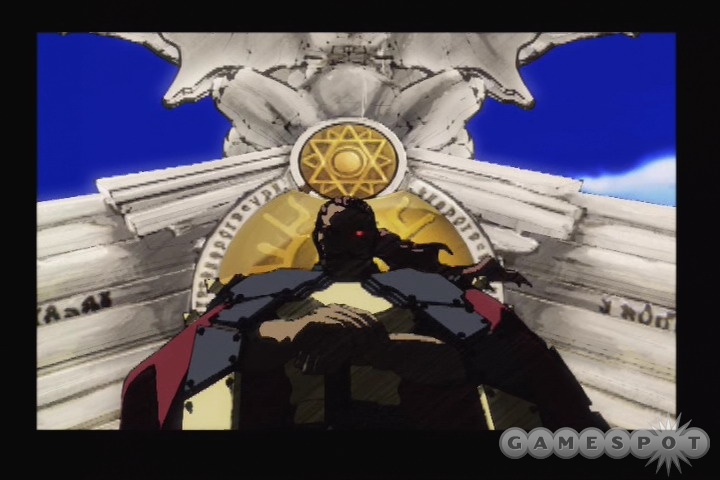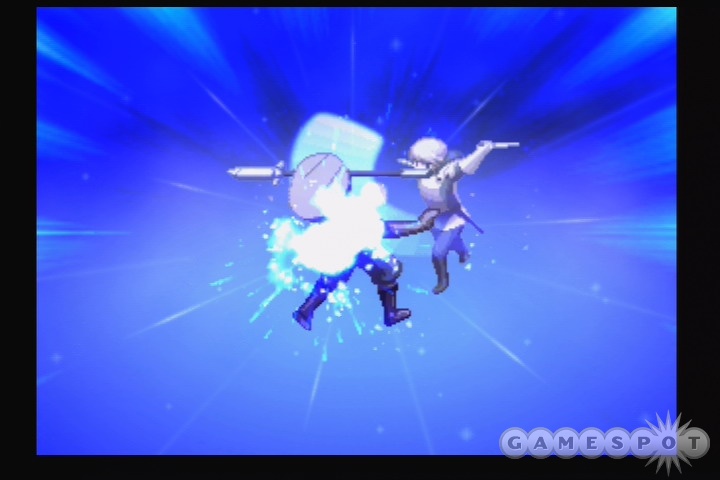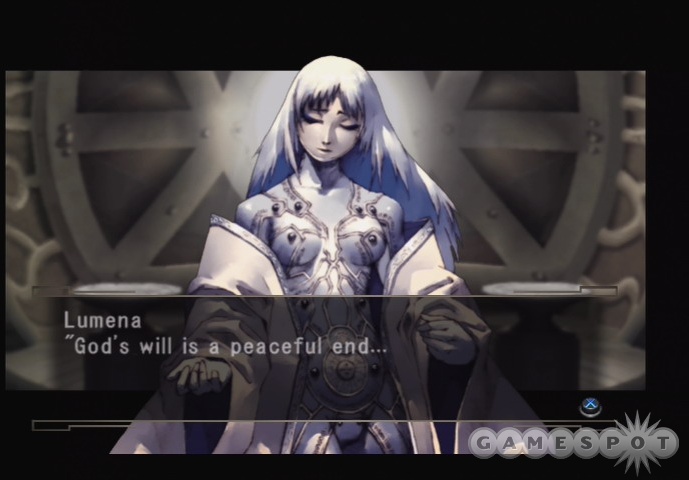Japanese turn-based strategy games have enjoyed their own niche on the PlayStation 2, the more notable representatives being Nippon Ichi's colorful and entertaining games. Stella Deus: The Gate of Eternity is not so brightly wrapped, but the game brings with it some unique gameplay elements and a great, ethereal visual style. This is a game that aims to appeal directly to the existing console strategy audience, and there's enough that sets Stella Deus apart to make it worth a look to those fans.

All those strategic battles need a conflict to revolve around, and the major source of stress in Stella Deus is that the world is dying. The lands of Solum are surrounded by a deadly fog known as the miasma, which is steadily advancing into the remaining populated areas, threatening humanity with extinction within a matter of years. The prevailing religious sect known as the Aeque preaches that God intends this slow destruction, and so his disciples should peacefully await their inevitable end. This doctrine of apathy makes Solum a pretty depressing place, but they've got more problems--a man named Overlord Dignus has decided to make the final years a bit more exciting by dominating the world with his military might. A young man named Spero and his friends end up straddling a conflict between the empire to which they belong and an underground rebellion that seeks to dispel the miasma with a structure called the Gate of Eternity. The race is on to see where salvation truly lies: through the Aeque's passive teachings, through the technological advances of alchemy, or through communion with the mysterious spirits that inhabit Solum and are tied to the Gate. The premise and the storytelling both do a good job of keeping matters interesting as you go along, even if saving the world might be a bit blasé nowadays.
Joining Spero and his companions in battle presents what is a familiar sight to fans of the genre, an isometric view with a grid-based map that lets your forces jostle for position and lay waste to your foes. All your options are governed by something called action points, or AP, which determine when the units on the field can act. Everything you do will cost AP, from moving, to attacking, to using special abilities and spells, to using items. This means that battles in Stella Deus aren't a matter of looking at a map, running to the very edge of your movement area, and unleashing your most powerful spell; you'll have to check your AP costs and be mindful of when you need to conserve them. It takes a bit of time to get used to this system (particularly for spells and special abilities, which require both AP to use and magic points to cast). Your AP refreshes to 100 each turn, and those with the most AP have the most initiative, which lets you do interesting things, like juggle your initiative with conservative moves to have a healer always ready to heal, or lure your enemies into long trips to expend their AP, letting you nail them. And so long as your party is of the appropriate level, nailing foes is generally easy enough with the wide array of skills you'll have at your disposal.
Your characters gain experience as well as skill points from defeating enemies, and the skill points can be used to purchase abilities. You can learn new special attacks, passive abilities (like a 10 percent boost to attack power or immunity to poison), and effect zone (EZ) powers that let you affect units in your immediate vicinity. EZ powers can be helpful to your allies (like giving a boost to evade or accuracy, or regenerating some health every turn), or they can be offensive (giving baddies bad status effects). EZ skills are nice, though everyone has a differently arranged effect zone, so sometimes you'll find yourself unable to take advantage of them efficiently. Skills vary by character class, and there are a number of these in the game--from fighters and swordsmen and samurai, to archers and clerics and alchemists, and more. You can "rank up" people with a special item to upgrade their class, and this gives them more skill slots to work with and new skills to learn. This is different from character class promotions in other games like Fire Emblem or Shining Force; your level doesn't reset, and the individual isn't altered in any way beyond getting additional abilities, so you can go ahead and rank them up as soon as they're ready.

There's some room for customization with skills, as you can get them from some items as well and have whomever you like spend the skill points to learn them, but for the large part you'll be using a character's innately learned set of abilities. Beyond some obvious tactical advantages (strong melee versus ranged magic and archers), the character abilities are fairly homogeneous, with all melee classes and ranged classes having equivalently strong skills. These are still fun to play around with, though, as are the team combo attacks you can trigger under the right conditions for massive damage. And you'll need those for the game's mighty boss characters, which almost invariably provide a nice stiff challenge. Possibly too stiff, if your characters are a little low in level--Stella Deus continues the long tradition of console strategies by being all about your party's level status. If you're too low, you'll need to catch up, but the game provides a relatively easy way to do this with the Catacomb of Trials.
You can hit the catacomb through a menu at any given point on the overworld (there are no random battles, thankfully). Each level of the dungeon corresponds to the strength of the enemies you find there, so floor two has level-two monsters, floor 10 has level-10 monsters, and so on. You have to clear a floor once to get to the next one, but once you've cleared a floor, you can go back to it at any given time. The catacomb serves as a sort of required "side dungeon." You can fully explore its depths at any time to satisfy any desire you may have to level your party to ludicrous strength, but even if you're not interested in that type of thing, chances are you'll still have to visit the place regularly to keep your group in tip-top condition. Time spent leveling almost always feels like a simple grind, and that's pretty true of this system as well. At least the chapters are relatively well arranged so that you'll usually be able to keep your main force fighting fit while having to hit the dungeon only once every so often to give yourself a boost or to prepare for a particularly tough fight. If you must level, this is one of the more accessible ways to arrange it, plus clearing a given floor will net you cash to spend on new equipment.

When you bring up the town menu while traveling, along with the option to enter the catacombs you'll have the option to visit the shop or the guild. The game's shop is streamlined to the point that gathering any weapons or items you need is a breeze--you can apply your new equipment directly to your party and then just purchase it all in one fell swoop, no fuss. The guild area lets you do two things: take quests and fuse items. Quests take many forms. Some of them let you purchase information, some of them have you go to a certain spot on the map to perform a specific task, and some of them will trigger battles for you in various locations. They're all pretty straightforward, but many are worth doing, for easy money as well as the possibility for recruiting new generic party members to fill out your ranks. Item fusion does just what it implies, letting you fuse two of your items and earn a new result. You can fuse just about every item in the game, and some items can be acquired only through fusion, so it's both fun to play with as well as genuinely useful. If you're the sort of player who loves maxing out your characters in every possible way, fusion is right up your alley, and both fusion and the catacombs give the already meaty story battles and progression a nice counterpart.
And the journey is made very easy on the eyes by some great artwork in the game. The character designs eschew both extremely cartoony and extremely "beautiful" character looks for a style that's soft but rich with detail. Fully armored warriors conjure images of tribal idols or old-fashioned robots, with full-face helmets and their sculpted metal features. Each generic class as well as each of the main characters is very distinct in appearance, both in the static art and the sprites, which animate smoothly and are well made. The various effects for special abilities, team attacks, and even normal melee also look really good and pack a nice visual punch. The animated cutscenes have a cool sketched form to them, and the color palette used is muted and misty, like the world in which the game takes place. The game's music has a similar take, light and airy in the overworld and energetic if subtle during battle, providing a steady undercurrent without drawing too much notice. There's a good amount of spoken dialogue, too, which at its worst is simply bland but otherwise moves the narrative along nicely.

Stella Deus doesn't set out to redefine its genre, but instead simply provides a good game of its type. Its battle system is slightly different but still easy to pick up and learn, and the skill and fusion systems allow for some character customization on already solid templates. The time you have to spend advancing in levels is something you have to be prepared for, but it's handled well for what it is and is balanced fairly well in the game as a whole. Console strategy fans should have a good time with this one.